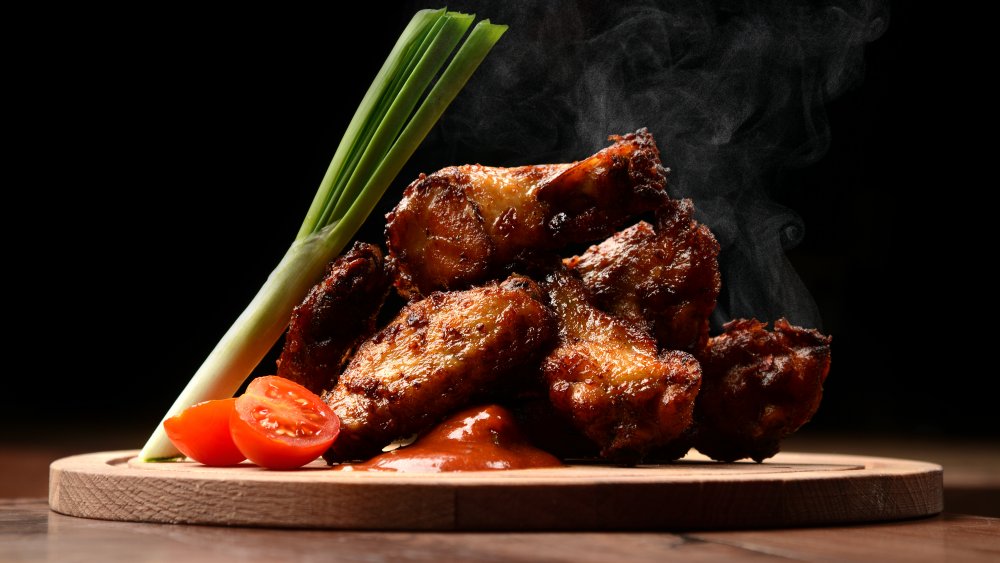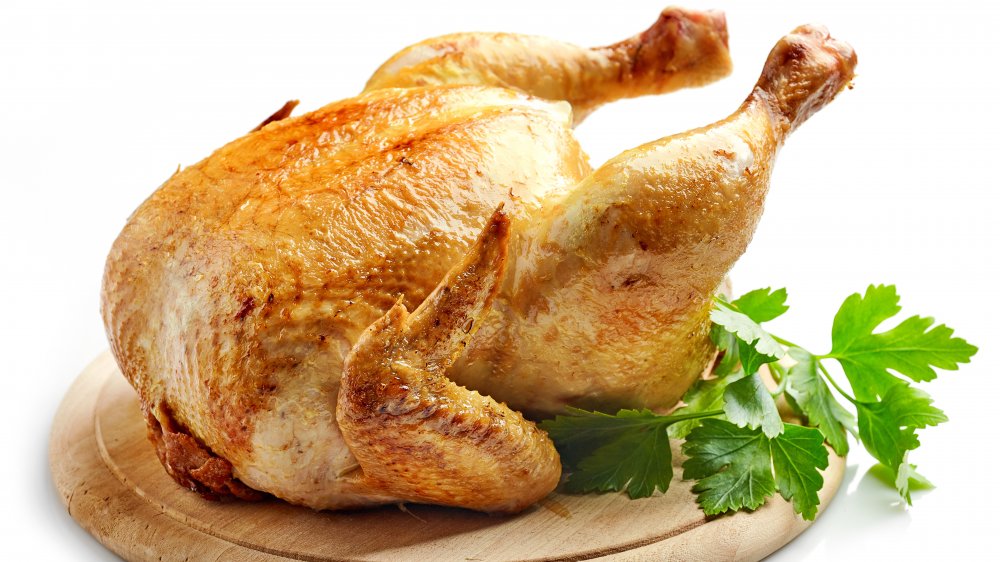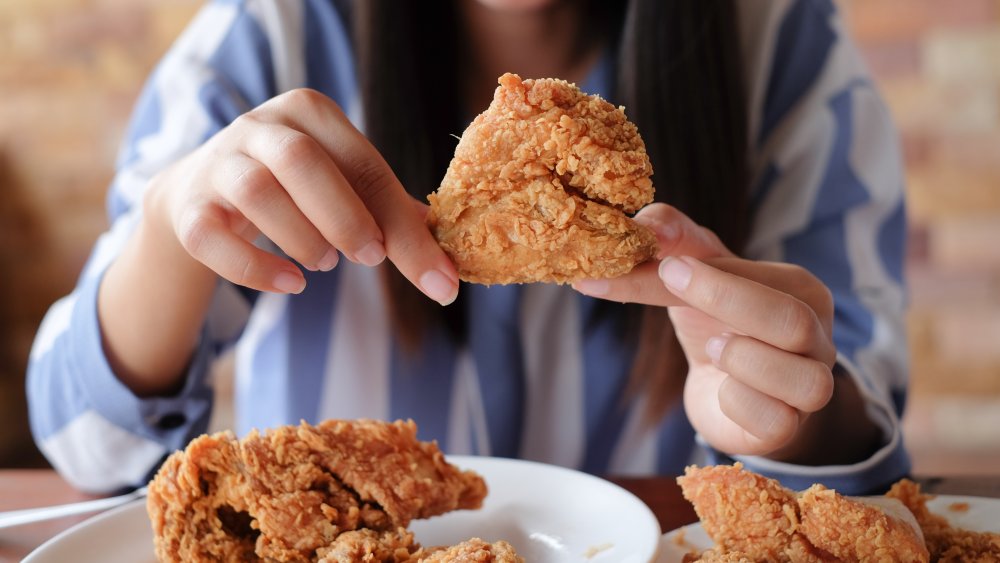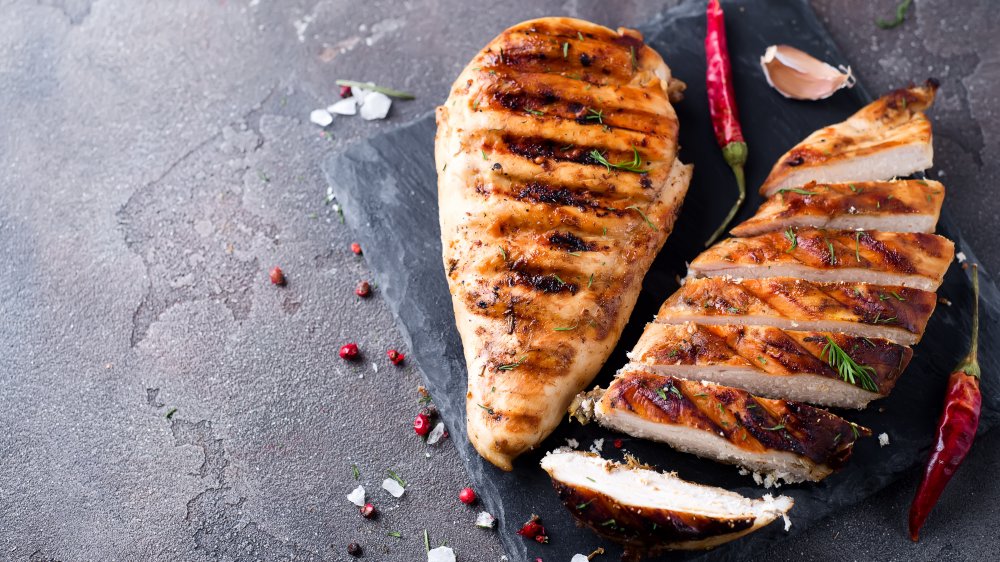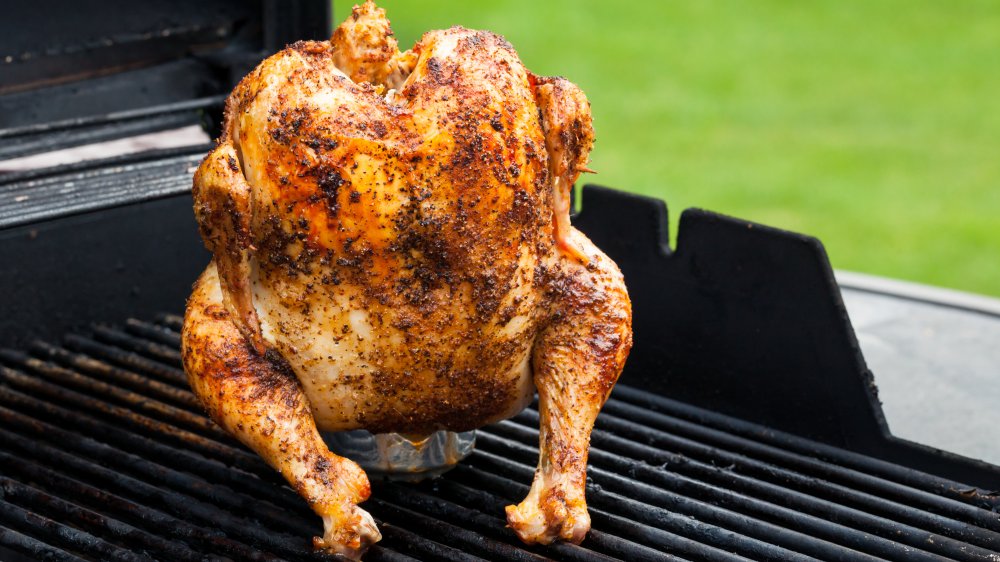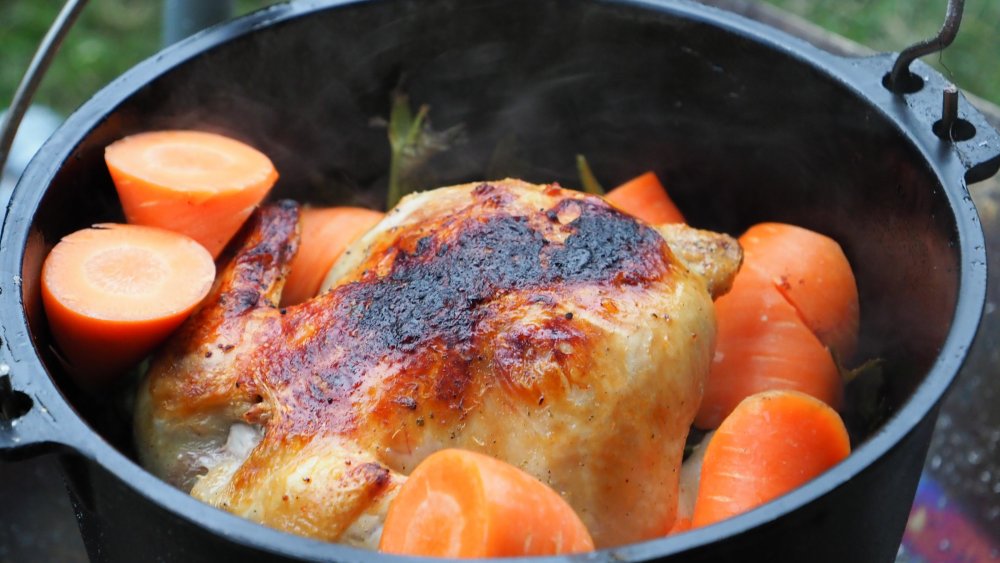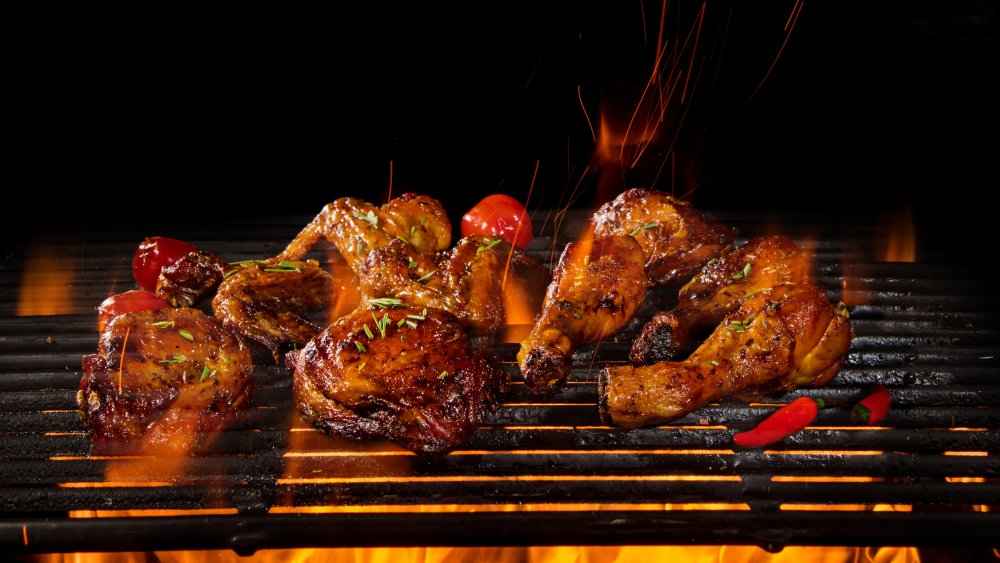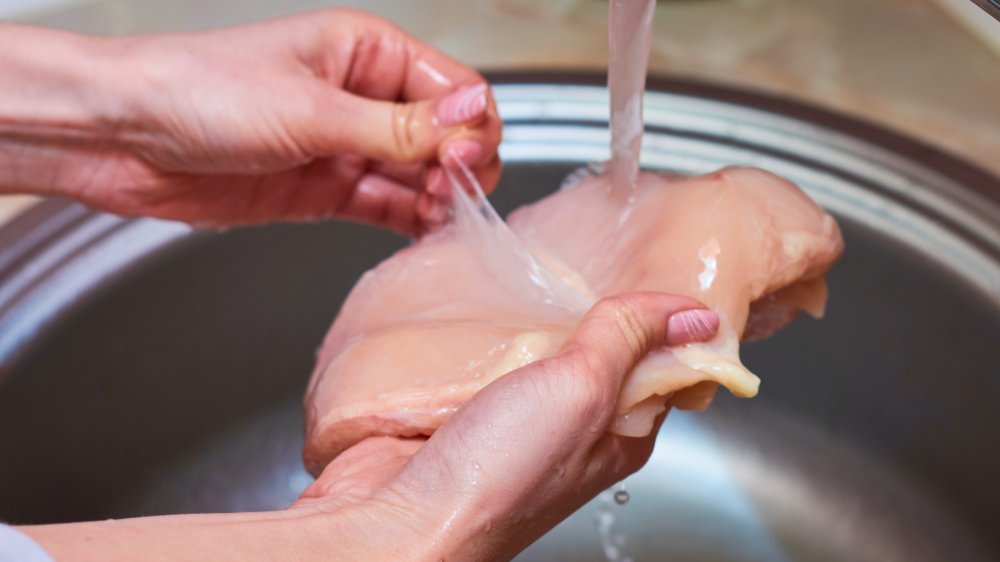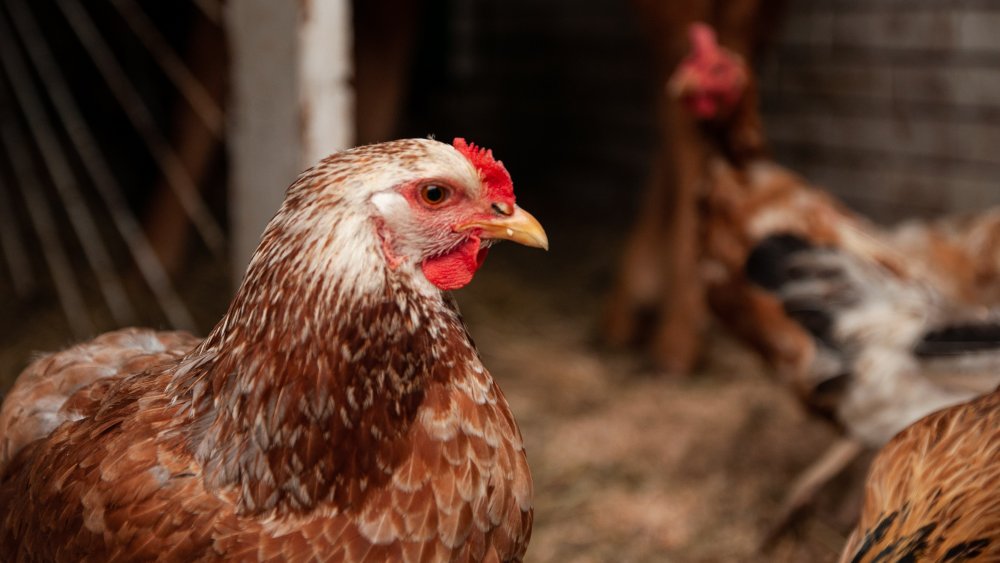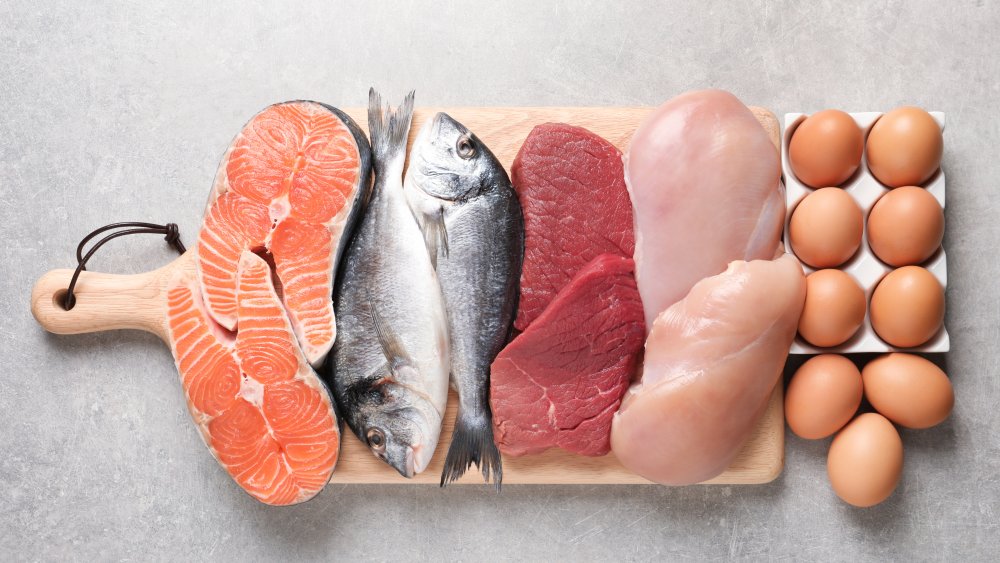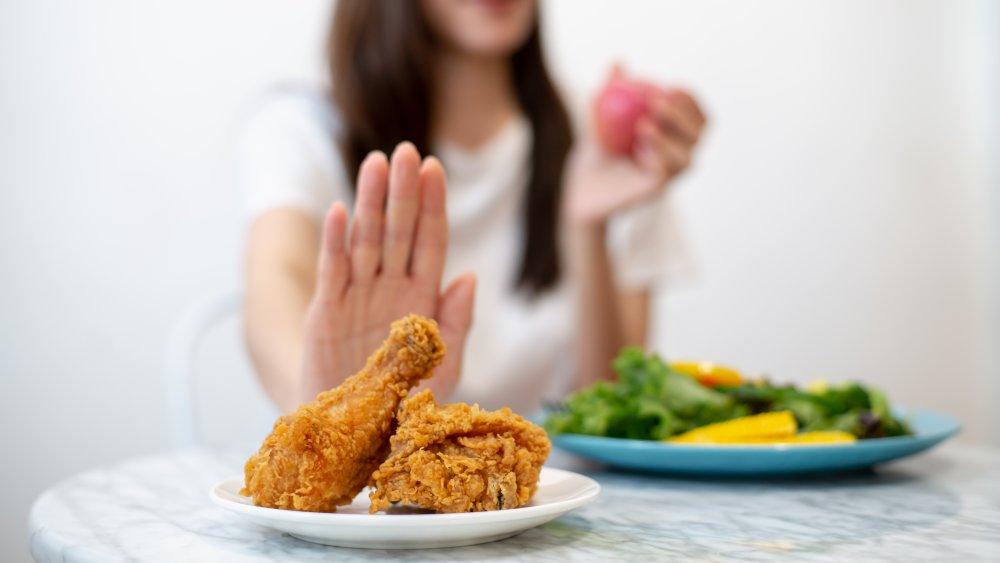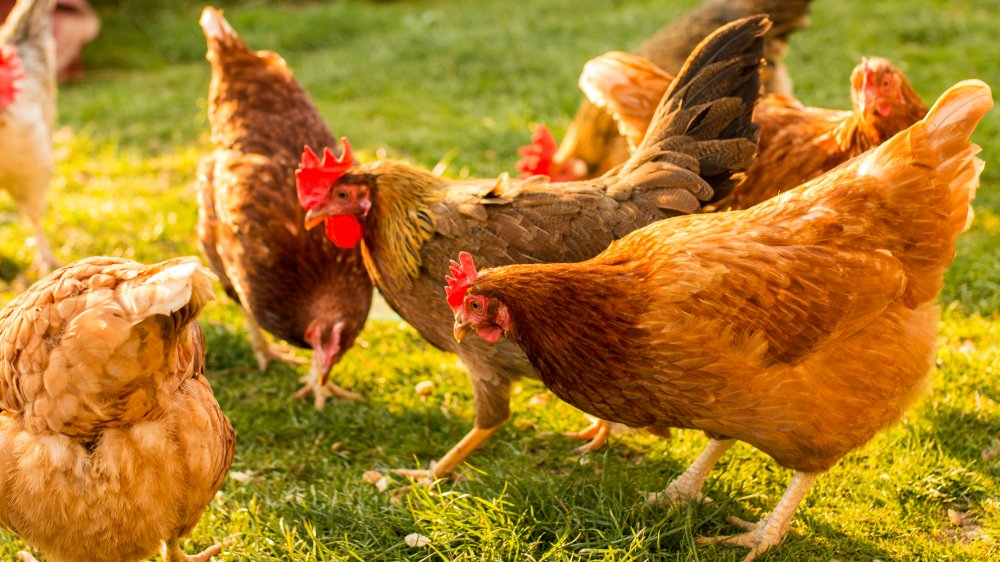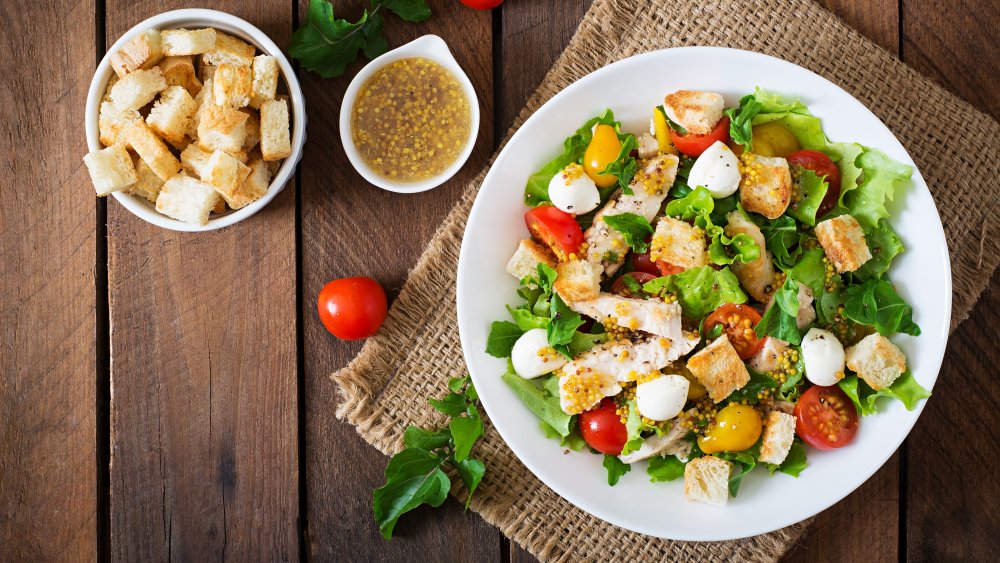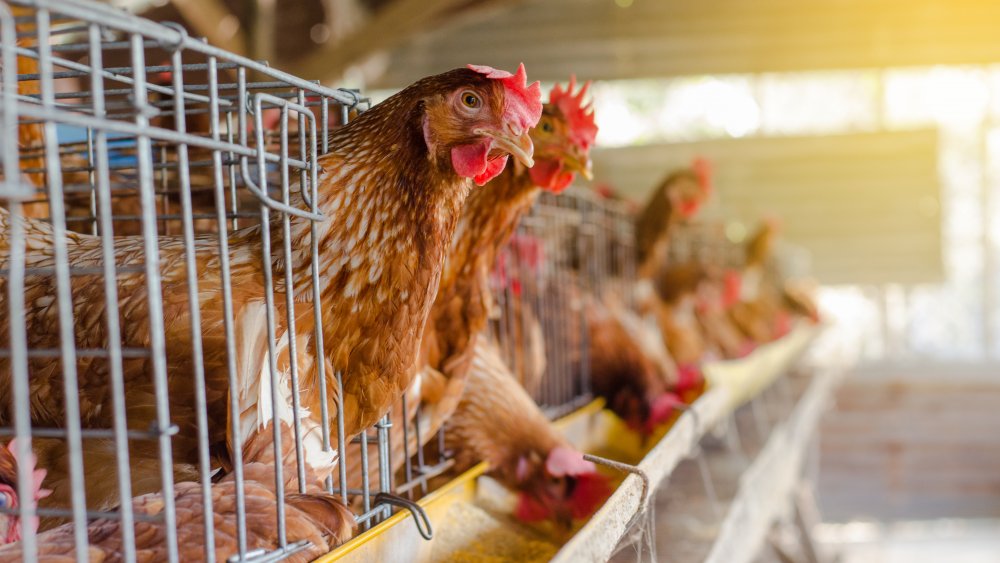The Common Myths About Chicken That Are Actually False
Chicken is a traditional, delicious addition to plates around the world. On average, people in the U.S. consume a staggering 201 pounds of meat annually. Chicken reigns supreme comprising almost half of the meat consumed, further outranking its standard competitors — almost double the amount of beef and pork eaten per person. Gone, however, are the days where the majority of chickens roam a cooks' backyard before reaching the plate. This disconnect of where and how our meat is raised could be, in part, why so many myths still exist about the best way to buy, prepare and cook the popular dish.
One reason for chicken's popularity is that poultry acts as the ideal blank slate for sauces or as a tender centerpiece of a meal. Fried, battered, grilled or roasted, personal preferences on how chicken "should be" cooked have often been shaped by the generation before. Unfortunately, many cooking myths have also been passed along with this knowledge. Today's shoppers instead are navigating a new set of rules. Many of the myths about chicken that need to be dispelled will help the culinary-inclined to make better decisions about their food, even before it reaches the kitchen counter.
These are the common myths about chicken that are actually false.
You should remove the skin before cooking chicken
For years, we've heard removing chicken skin is the healthier way to eat. Cardiologists and nutritionists once spoke of the havoc fats caused, and as a result, encouraging everyone to go to "low fat" in their diets. This low-fat lifestyle applied to a range of foods, including your delicious rotisserie and baked chicken. Turns out there are good kinds of fat that humans need to thrive. Chicken skin contains the healthier unsaturated fat that can actually improve cholesterol levels and lower the risk of heart disease.
Plus, any cook that is still skeptical should be aware removing chicken skin before cooking dries out the tender meat. Leaving the skin on not only results in a moist and flavorful dish, but lets cooks use less salt in preparation. Salt might be an excellent way to flavor meat but too much leads to high blood pressure, heart disease, and stroke. So much for all the good fats.
By leaving on the skin, you can also negate the need for using any less health-conscious coatings — even though breaded chicken makes for a mouth-watering meal. Chicken skin is actually the healthy and delicious choice for today's kitchen.
Fried chicken tastes better when crisped in the oven
Southern-style fried chicken is a staple of summer. Many cooks take their fried chicken recipes seriously when it comes to gaining the ideal crispy, yet juicy, piece of meat. How to achieve that balance varies greatly depending on who you ask. One myth stands out for taking the extra step of crisping fried chicken in the oven to achieve an extra crunch in the flour coating. Food & Wine explains you don't need to bother with this step to make true southern-style fried chicken. The coating itself is really where the enviable crunch is going to be achieved.
You just need a Dutch oven to keep the splatter to a minimum, although traditionalists will stick to a cast iron skillet. To elevate the recipe, add some corn starch in the flour to weaken the flour's protein, resulting in a crispier and flakier final product. You can also include some Southern bourbon in the buttermilk and egg mixture to help set the coating and create more of the irresistible flakes. And don't worry about serving hard spirits to the family, the alcohol burns off in the frying process to ensure no one will feel the effects.
Chicken is done cooking when the meat is not pink
Anyone without a meat thermometer might be tempted to believe this cooking myth. We know chicken is one type of meat that requires thorough cooking to avoid bacterial infections. For safety, all poultry must be cooked to the internal temperature of 165 degrees Fahrenheit. However, many cooks still believe the traditional method of checking the color to determine if the piece of chicken is done. Checking to see if the meat is still pink won't actually tell you if the chicken is ready to eat. Even waiting until the juices run clear isn't a certainty.
The only reliable way to know if a piece of chicken is cooked all the way through is to use, you guessed it, a meat thermometer. The USDA recommends caution by checking the temperature reaches 165 degrees inside to ensure it's not overdone — or under-cooked. It's not unusual for a chicken breast that's fully white when it's cooked to be dry and overdone. Fortunately, thermometers are a cheap and simple way to achieve peace of mind.
Beer moisturizes the meat when using the beer-can chicken technique
The beer-can chicken recipe become popularized thanks to cookbooks, a Keith Urban song, and die-hard fans on the internet. This myth about cooking chicken is one technique to steer clear from. Beer-can chicken involves placing a beer of your choice inside the chicken cavity while cooking, a method devotees claim results in a more tender and flavorful chicken. Plus, it offers a unique visual when there's an audience.
According to meat aficionado Meathead Goldwyn at the Food Network test kitchen, there is no way for the beer inside the can to escape and make contact with the flesh of the bird. The can blocks sideways movement of the beer and also doesn't allow the adult beverage to reach a temperature to steam out of the metal. He also explains for anyone who might believe the beer crisps the skin on the outside to remember that the interior beer can is blocked by at least an inch of meat.
Real health concerns also come into play about using the can itself. Manufacturers don't test the plastic liners inside the can to withstand cooking temperatures, because that's not what they're intended for. To make matters worse, the ink on the outside of the can could get on the chicken itself and is unlikely to be food grade. In the words of Annheuser-Busch, maker of Budweiser and other beers, "While many people swear by these methods, and apparently they produce some delicious results, it's not one we endorse or recommend, since we don't design our cans for this purpose."
Using a bundt pan cooks a chicken similar to a vertical roaster
We've already learned you can't trust everything on the internet, and this cooking technique for chicken is one that evokes some skepticism. According to endorsements by some online sources, home cooks can roast a chicken, turkey, or any piece of meat in the oven using a bundt pan. Placing the chicken cavity over the cone at the center will keep the meat from touching the bottom, and allow for the effect of a vertical roaster. The recipe even calls for vegetables at the bottom in order to cook an entire meal in one fell swoop.
AmazingRibs.com science advisor Prof. Greg Blonder calls this "an unspeakably bad idea." Using a bundt pan as a vertical roaster won't offer the desired results for anyone looking to cook a crisp roasted chicken. "It won't speed up cooking, and the pile of vegetables and juices will create a low temperature sauna that steams instead of roasts the meat," he explains. Home chefs will be left with soggy skin and undercooked thighs. Instead, Blonder recommends cooking with a Dutch oven. At least it's not a myth that Dutch ovens really do offer an excellent way to cook chicken.
You need a deep fryer to make ultra-crispy wings
Achieving crispy wings, regardless of how they are battered, fried, baked, or roasted, is a priority for many wing lovers. Not everyone, however, can find a place in the kitchen for a deep fryer, or is brave enough to fry pieces in a high-temperature skillet. Luckily, cooks can place wings on a grill and still reach peak crunch. A bit of corn starch on the outside will ensure a flaky exterior. You don't even need to use flour to get the full battered treatment.
Tossing dry pieces of chicken in olive oil first will help the seasonings stick. Then, place each piece of chicken on the grill with some seasonings to get the ideal crispy texture. Wings will cook for about 35-40 minutes with the lid closed. Flip as needed to promote an even crisp, and don't forget your favorite sauce when they're done.
Chicken needs to be washed before it's eaten
The traditional process of washing chicken before it's cooked can be thrown out with the bath water. Due to modern food safety practices, the USDA Food Safety and Inspection Service does not recommend washing raw poultry, or any other meat for that matter. The problem is that when you wash raw poultry, bacteria from the raw meat and juices can spread to other foods, cutting boards, cookware, and surfaces throughout the kitchen. Bacteria can easily spread to surfaces, and most cooks understandably don't stop mid-preparation to fully sanitize their sink, counters and utensils.
The need to clean your poultry before cooking wasn't always a myth — it was a common practice when home cooks slaughtered their own meat. These days, meat is cleaned when it's processed, and doesn't need to be sanitized at home. The best way to kill the bacteria that might develop or be present is to cook your poultry — no suds required.
Chicken labeled without antibiotics doesn't contain any antibiotics at all
Antibiotics are a confusing (and unsavory) subject when it comes to buying the best chicken for your dinner plate. Antibiotics are sometimes used to speed up growth in chickens and keep them healthy. The use of antibiotics to raise animals is common in production across the globe. Members of the science community have been pointing to the dangers of feeding animals drugs used by humans to fight infections for decades. Using antibiotics similar to ones humans depend on leads to drug resistance in the general public.
The Guardian found most meat animals are raised with the assistance of doses of antibiotics on most days of their lives leading to over 63,000 tons of antibiotics used per year. In recent years, antibiotic-free chicken is often preferred due to health concerns and personal preference.
Consumer Reports found that some labeling regarding antibiotic use can be deceptive to consumers, and may have led to some myths about what chicken meat is free from the drug. In order for chicken to be labeled organic, it can be given antibiotics only in the hatchery. Only those labeled "raised without antibiotics" are truly free from antibiotics. A perhaps less clear label is "no medically important antibiotics." This designation actually means poultry is fed other antibiotics not available for human use.
Natural chicken doesn't contain additives
Food labeled "natural" is nothing more than a marketing ploy. It's truly a myth that "natural" foods are healthier for you. The problem really, it turns out, is what many shoppers expect from the label. While 62 percent of shoppers said they often buy foods labeled as natural, according to Consumer Reports, nearly two-thirds believe the natural food label means more than it actually does. These same consumers also believe, incorrectly, that natural foods are produced without genetically modified organisms (GMO), hormones, pesticides, and other artificial ingredients.
Food-safety experts examined typical foods found in the grocery store, including pre-packed chicken strips from the producer Tyson. The product contained multiple corn sweeteners and citric acid, typically a lab-produced additive derived from bacteria. When Tyson was asked if any of their ingredients came from GMO corn, the food brand responded that the government's "natural requirements do not address GMO," and it's true. The strips are just one example of the types of additives allowed in chicken labeled "natural." Dispelling this food myth will allow shoppers to be much savvier in the store, and make the best personal decision for their plates.
Buying hormone-free chicken is the healthier option
Buying hormone-free chicken might seem like the clear winner when comparing meats. Shouldn't the label hormone-free chicken also indicate it's the better option for shoppers? The reality is a little more complicated. None of the chickens raised in the U.S. or internationally are given hormones. In fact, feeding chickens additional hormones, other than the hormones the animal produces on its own, has been illegal in the U.S. since the 1950s. While it's beneficial for shoppers that the practice stopped, it might come as a surprise to some cooks.
Instead, labels for hormone-free chicken are just a clever marketing ploy to draw in health-conscious consumers. The label is similar to the meaningless designation "farm raised." Spoiler alert, all animals destined for meat consumption are technically raised on farms. The only difference between chicken labeled hormone-free and chicken not given that label is how the company chooses to market the product.
Free-range chicken comes from animals raised roaming in green pastures
The term "free-range" might make you think of a happy and healthy animal moving freely in a pasture and pecking for food, but in most cases that's nothing but a myth.
The U.S. The Department of Agriculture issues "free range" certification to poultry operations that simply allow birds access to the outdoors. Heathline explains "free range" doesn't mean the poultry must be allowed access to pastures or grass. Farmers also don't have to ensure a certain amount of time outdoors or the size of the area for a given number of birds. Outside space isn't defined, leading to certain producers offering less than ideal conditions. Free-range chicken might only have access to a patch of gravel.
If shoppers are committed to buying meat raised outdoors, chicken that's labeled "certified humane pasture-raised" or "certified humane free range" requires additional space and outdoor grazing.
Buying vegetarian-fed chicken is the new healthy choice
It's becoming more common to see free-range chicken labeled as vegetarian-fed hens. We're here to dispel another myth about how chicken is labeled merely for marketing purposes. Vegetarian-fed chicken is labeled on meat and eggs as a benefit to the consumer but what that benefit might be is unclear. Chickens are actually omnivores, which means they prefer to eat bugs and small animals in the wild. While free-range chicken isn't quite the pastoral life as many shoppers expect, any vegetarian-fed chickens are likely getting even less of the time outdoors than the name suggests.
If a bird is "vegetarian fed," the Healthy Home Economist explains the chickens are unlikely to gain access to grass, dirt, and insects outdoors. Instead of delicious neutral proteins chickens eat in the wild, the birds are given protein replacements. The vegetarian feed the chickens are eating is most likely heavily loaded with GMO soy. This results in poorer quality, low nutrition eggs and meat for consumers. This is also a problem for anyone with soy allergies because second-hand soy products end up in the eggs. Research has shown people who are allergic to soy may also react to eggs, dairy and meats as a result of the animal's diet. Just another reason to know what you're getting when buying soy-fed, aka "vegetarian-fed" chicken.
Cage-free chicken is a special designation for higher-end meats
Now that we've learned what "free range," "natural," and "hormone-free" chicken does and doesn't mean, the cage-free label might raise healthy skepticism — and rightfully so, because the fact that cage-free chickens are best is nothing more than a myth. Charging more for cage-free chicken is a scam since it's an industry standard. None of the chickens raised for meat in the U.S. are kept in cages. "Cage free" is similar to "free range" in that it doesn't mean the birds have access to the outdoors. Instead, most cage-free hens live in flocks of thousands of hens and never go outdoors. Sad but true.
This terminology "cage-free" is, however, important for shoppers looking for eggs from humanely raised poultry. While the term cage-free is just another marketing ploy for meat, it's an important distinction when buying eggs. The majority of egg-laying hens are raised in battery cages, and the Humane Society explains this space is the equivalent of living on a single sheet of letter-sized paper for her entire life. Cage-free hens are able to walk, spread their wings and lay their eggs in nests, vital natural behaviors denied to hens confined in cages.
